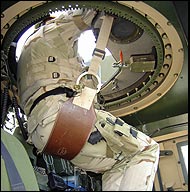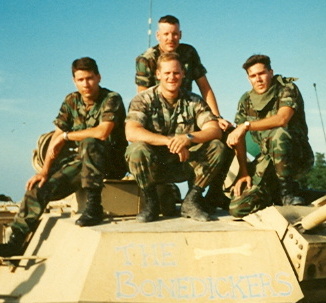As a former Guardsman, I find this analysis of the almost-wholesale restructuring of the National Guard intriguing (hat tip to the Officer’s Club).
The Army National Guard’s transformation, highlighted by the organization of 34 new modular brigades, continues to march toward a programmed completion date of 2008.
The transformation to these cost-effective, rapidly deployable formations is occurring in the midst of ongoing deployments overseas in support of the Global War on Terror, as well as extensive deployments here in the United States for Operation Noble Eagle and for domestic disaster response.
[…]
For much of 2005, the Army Guard contributed half of the Army’s combat forces on the ground in Iraq. These combat-proven units in many cases returned to immediately begin transformation to the new, modular configuration, with the goal being to make them identical in structure and manning to their active Army counterparts – though at a considerably cheaper price, since the Guard units are manned by part-time citizen-soldiers.
Seventy-three percent of all Army National Guard units are affected by transformation – the largest shift in Guard force structure since the end of World War II. The transition began in fiscal year 2005.
As in the active component, the Guard’s brigade combat teams come in three types – Infantry, Armored (formerly called “Heavyâ€), and Stryker. In addition to the BCTs, the Army Guard will also be fielding a number of new modular supporting units – six “Fires Brigades,†10 “Combat Support Brigades (Maneuver Enhancement),†11 Sustainment Brigades, 12 Aviation Brigades, an Aviation Command and three Sustainment Commands.
As in the Regular Army, the eight Army National Guard Divisions are shedding all their organic structure and transforming to a modular, deployable command and control headquarters.
In peacetime, the Guard division headquarters will have training and oversight authority for four or five BCTs located in the same geographic area. In wartime, each division will have a variable number of BCTs and support units attached to it depending on its mission.
In addition, Guard division headquarters will have the capability to exercise command and control in a domestic emergency, as did both the 35th and 38th Infantry Divisions following Hurricane Katrina.
[…]
The transition to 34 Brigade Combat Teams represents a considerable reduction in the Army National Guard’s combat force structure from only five years ago. In 2000, the Army Guard consisted of eight complete infantry divisions, each consisting of three maneuver brigades, plus 16 separate brigades, an Armored Cavalry Regiment and an Infantry Group, for a total of 42 ground maneuver brigades or their equivalent. The Army Guard’s authorized strength of 350,000 in 2000 was the same as it is today.
The transition is even more dramatic when compared to the Cold War height of the Army Guard in 1989, when strength stood at 457,000 and the Guard fielded 53 ground maneuver brigades or their equivalent.
The reduction in forces is equally dramatic in other branches, most notably Field Artillery. There, the Cold War reserve of 17 Field Artillery Brigades and a Corps Artillery Headquarters that are currently in the Guard will shrink to six “Fires Brigades†by 2008.
[…]
Overall, the conversion to modular units led to a large decrease in the number of field artillery and armor battalions in the Guard, and an increase in the number of cavalry squadrons.
Despite the broad and sweeping changes, several nods to history have been acknowledged so that the proud heritage of individual states could be recognized or maintained.
Extensive evaluation and input from the states since then has led to a few significant changes to the Army National Guard picture.
Perhaps most noticeable is the new designation and insignia that will be worn by Virginia’s Brigade Combat Team. Initially, the unit was to be designated the 116th BCT, 29th Infantry Division, and Soldiers would have continued to wear the 29th Infantry Division patch they currently wear.
Virginia’s leaders decided instead to designate the unit the 116th Infantry BCT and adopt the shoulder sleeve insignia of the former 116th Infantry Brigade, the famed “Stonewall Brigade.†That patch sports a profile of Thomas “Stonewall†Jackson, the legendary Confederate commander from Virginia, astride his horse.
In another change from the October announcement, Louisiana’s 256th BCT will continue to be called “Infantry†for tradition’s sake, even though its structure will remain that of an “Armored†BCT.
The Army Guard will also have two armored BCTs – the 116th in Idaho and the 278th in Tennessee – that will adopt the designation “Cavalry BCT†because these units have long histories of service as cavalry organizations.
Another example would be the resurrection of Texas’ 36th Infantry Division and its distinctive T-patch to replace the 49th Lone Star Armored Division, discussed previously.
The Officer’s Club had graphical representation of the new structure of a heavy brigade combat team, which I’ve managed to track down to Global Security.org (click on image for larger version).


